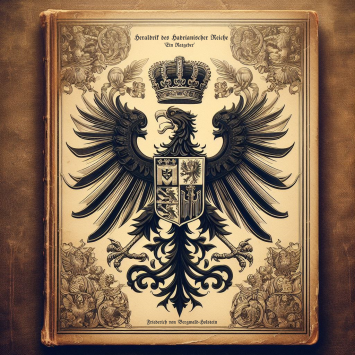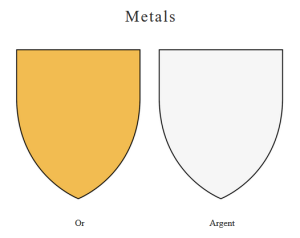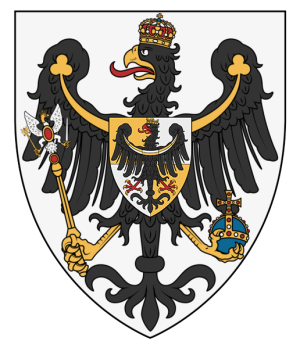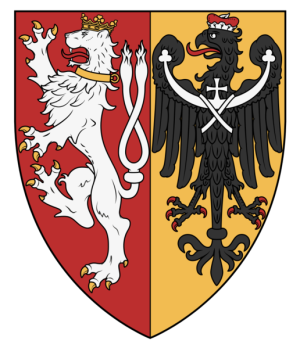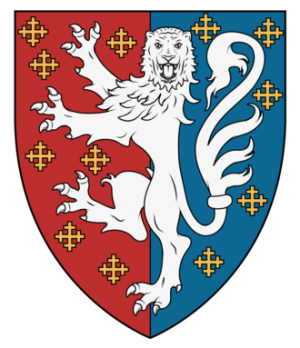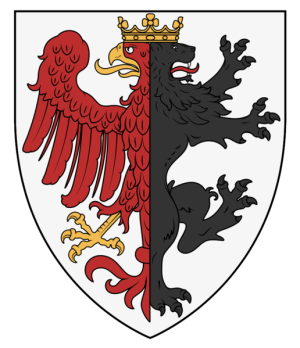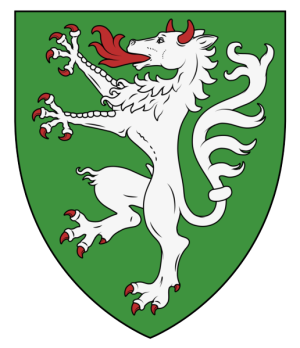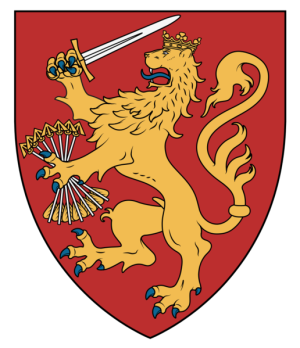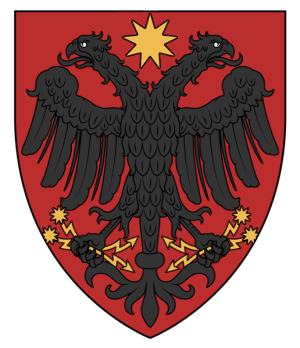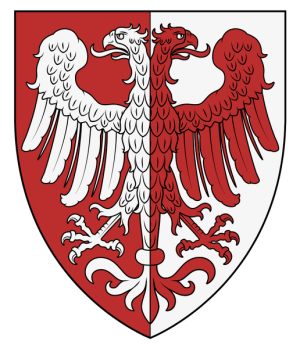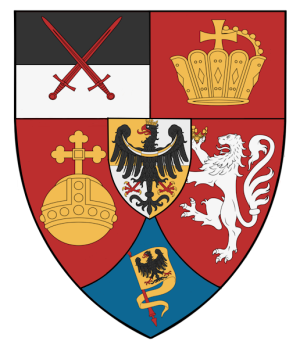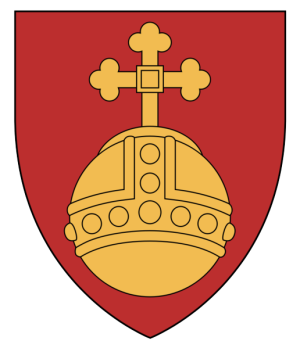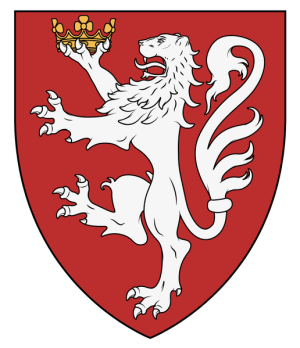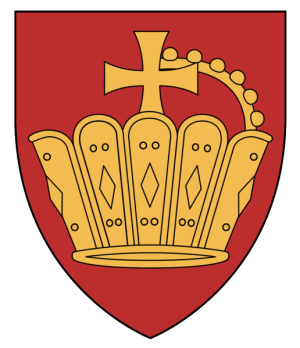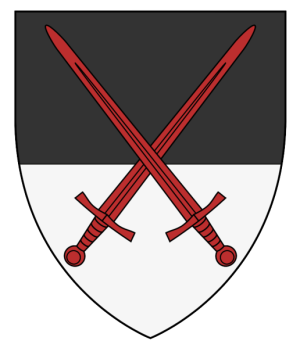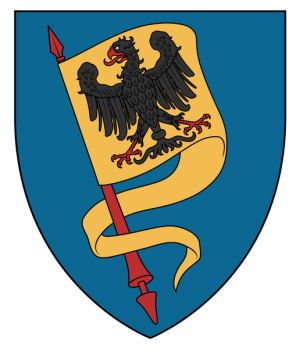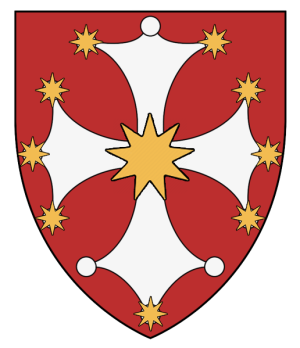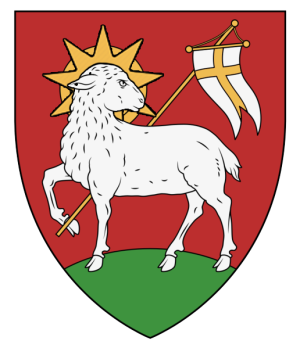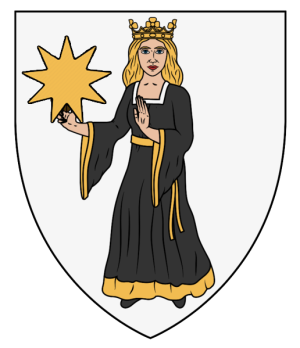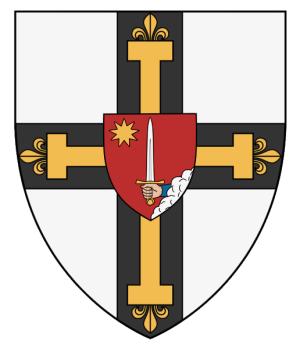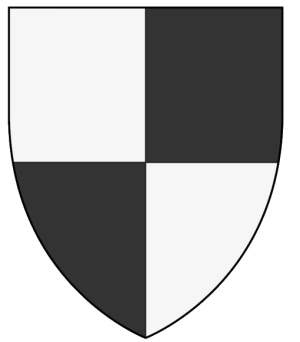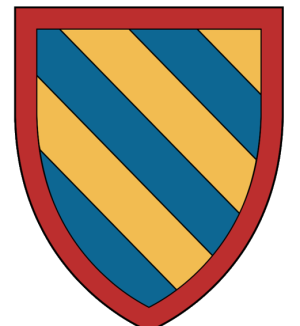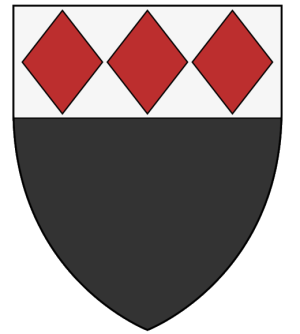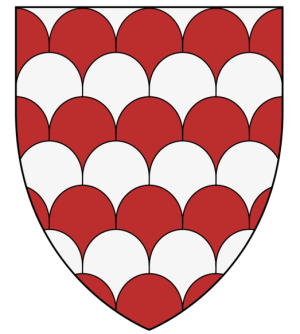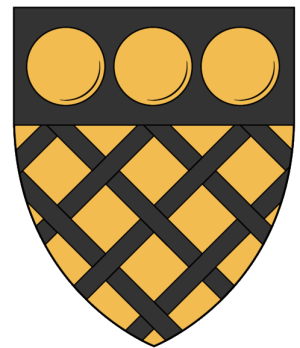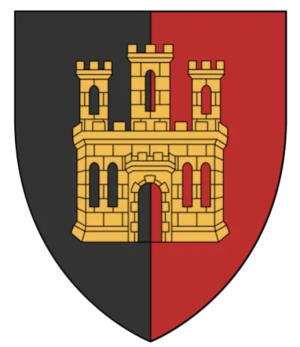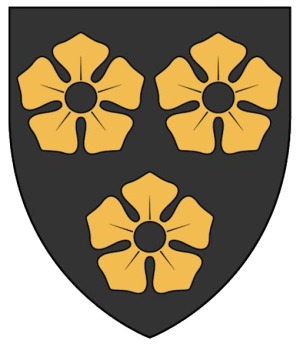Heraldry of the Hadrian Empire: Difference between revisions
FablesAdmin (talk | contribs) No edit summary |
FablesAdmin (talk | contribs) |
||
| Line 38: | Line 38: | ||
=== The Grand Principality of Brandenhafen - ‘Das Großfürstentum Brandenhafen’ === | === The Grand Principality of Brandenhafen - ‘Das Großfürstentum Brandenhafen’ === | ||
A plain argent shield adorned with a crowned eagle charge, the eagle is holding two items | A plain argent shield adorned with a crowned eagle charge, the eagle is holding two items. His left claw holds a relic adorned with gules and argent gems, serving as an allusion to the Globus Cruciger, also known as the orb charge, which is a symbol of power. It is an emblematic representation of sovereign authority and is frequently accompanied by the scepter - which can be seen held in his right claw, the baton of command with the statuette of the Imperial Eagle himself affixed to its end. Lastly, a central shield can be spotted. This central shield is made up of a party per cross in the tinctures or and argent, with a crowned eagle charge and stands as the current crest of the Imperial Family: ''von Lichtenfelts.'' | ||
[[File:Krownlands.png|frameless]] | [[File:Krownlands.png|frameless]] | ||
Revision as of 22:27, 4 January 2024
Introduction
| Author | Friederich von Bergwald-Holstein |
| Country | The Hadrian Empire |
| Language | High Attian, Common Tongue |
| Subject | Guide |
| Publisher | The Imperial Library of Adelsburg |
| Publication Date | Moonday 1, Redfall, 1541 |
Ever since the dawn of the Attian Empire, various symbols and flags have been used to represent individuals, families, or groups. Throughout the ages, simple colored cloths and small symbols sewn into the clothes of people have developed into extravagant symbols made by prestigious artists to represent great houses, families, kingdoms, and other allegiances. These heraldric symbols, or crests, are in modern times a popular and commonly used way to express one’s wealth and prestige within the Hadrian Empire. The more extravagant the symbol, the more prestigious its wearer’s house or company. There are a multitude of crests used throughout the empire and all use a very defined style. This article acts as a guide and overview of Hadrian heraldry.
Hadrian Heraldry
Officially used colors of Hadrian Crests
Heraldry of the Imperial Provinces - ‘Heraldik der Reichsprovinzen’
‘The crests that are depicted in this catalog are formally accepted by the Hadrian Empire as the crests of the Empire. Any crest not in this catalog is unrecognized within the borders of the Empire’
Every noteworthy location, group, or region within the Hadrian Empire has its own crest. Some have been in use since the days of old, and have evolved throughout many different renditions as time passed on, whilst others have recently been designed and added to the ever-growing list. To find a way in this maze of Imperial Heraldry the chroniclers of the Empire have put their pens together to create a catalog to categorize and display every known crest of the Empire. Depicted below are all crests of the Hadrian Empire, their meaning, useful history, and technical aspects.
This first section of the catalog is dedicated to the Imperial Provinces.
The Grand Principality of Brandenhafen - ‘Das Großfürstentum Brandenhafen’
A plain argent shield adorned with a crowned eagle charge, the eagle is holding two items. His left claw holds a relic adorned with gules and argent gems, serving as an allusion to the Globus Cruciger, also known as the orb charge, which is a symbol of power. It is an emblematic representation of sovereign authority and is frequently accompanied by the scepter - which can be seen held in his right claw, the baton of command with the statuette of the Imperial Eagle himself affixed to its end. Lastly, a central shield can be spotted. This central shield is made up of a party per cross in the tinctures or and argent, with a crowned eagle charge and stands as the current crest of the Imperial Family: von Lichtenfelts.
The Grand Duchy of Veronia - ‘Das Großherzogtum Veronia’
This crest, carrying the tinctures of the old ‘Kingdom of Veronia’ consists of a party per pale divisioned shield, with two separate charges on each side. The left side is in the gules tincture with an argent lion rampant crowned charge, this lion stands tall as a protector of Veronia and refers to Veronia's prominent role in guarding the southern coasts with their bastion Cerils’ Keep. Furthermore, on the right there is a sable crowned eagle charge against an or tincture, referring to the Imperial Eagle.
The Grand Duchy of Hertzland - ‘Das Großherzogtum Hertzland’
A shield with a party per pale division in the tinctures of gules and azure. On it an argent lion rampant guardant charge. The lion symbolizes courage and strength, but also nobility and royalty. A nod to the older times of the Kingdom of Hadriana, in which the Province of Hertzland was the seat of the Hadrian Royalty. This former Hadrian Royalty, the Withmonds are the reason this crest still carries the argent and azure tinctures, as they were the house colours of the then king Roderick Withmond.
The Duchy of Bergwaltz - ‘Das Herzogtum Bergwaltz’
A plain argent shield adorned with a two-headed charge. The charge consists of a jules eagle crowned on the left, and a sable lion rampant crowned on the right. The eagle refers back to the Imperial eagle of the Hadrian Empire, whilst the lion stands for courage, strength, and valour.
The Duchy of Hölzland - ‘Das Herzogtum Hölzland’
A shield covered in a vert tincture without divisions. This tincture is a nod to the vast forest that covers seventy-five percent of the Hölzland province. On this shield, a panther rampant charge in the argent tincture stands as a center-piece.
Unbeknownst to what this creature is supposed to resemble, the older inhabitants of Hadriana were raised on legends that have been handed down through the generations: a formidable being lurking in the forest, resembling a panther and possessing the menacing head of a mighty steed. It remains to be determined whether the Hadrian folklore regarding the fire-breathing creature is merely a story to scare the younglings or whether it continues to linger among us.
The Duchy of the Southern Hinterlands - ‘Das Herzogtum das Südische Hinterland’
A plain gules shield with an argent lion rampant crowned charge. The lion, which stands for courage and strength, was often seen on old Hintish crests and has carried it over to the current rendition. This lion appears to be holding seven arrows in its left paw. These seven arrows are a direct reference to the first seven major Hintish tribes that made up the old Hinterland Kingdom. The sword in the lion's right paw stands for defiance and has no deeper meaning.
The Duchy of Holstein - ‘Das Herzogtum Holstein’
A crest tinctured in gules without divisions with a sable double-headed eagle charge as its center-piece. This eagle which refers back to the Imperial eagle is depicted with two heads, an indication of the province’s importance on a military level. These two heads serve as a symbolic representation of the province's first line of defense, which functions as a beacon of high alert to ensure that no threat breaches the borders. As the two heads cast their gaze in every direction, the province similarly offers the Empire protection, safety, and reassurance.
The Duchy of Flüssland - ‘Das Herzogtum Flüssland’
The newest of all province crests. This shield in a party per pale division. The left side in gules, while the right side is argent. The two-headed eagle charge is in opposite tinctures, with argent on the left and gules on the right. Similar to the ducal crest of Holstein, this double-headed eagle not only alludes to the Imperial Eagle himself but also symbolizes the province's high level of defense, enforcing the border with its double-headed gaze and preventing any potential threat from crossing.
Heraldry of the Imperial Council - ‘Heraldik der Reichstag’
Imperial Council - ‘Reichstag’
WIP
ErzSteward - ‘Erzverwalter’
WIP
Erzcupbearer - ‘Erzmundschenk’
WIP
Erztreasurer - ‘Erzschatzmeister’
WIP
Reichsmarshall - ‘Reichsmarschall’
WIP
Erzbannerbearer - ‘Erzfahnenträger’
WIP
Heraldry of the Temple of Alder - ‘Heraldik des Alder-Tempels’
The Holy Temple of Alder - ‘Die Heilige Tempel von Alder’
WIP
The Grand Cathedral of Alder & the Vater - ‘Die Große Kathedrale von Alder & der Vater’
WIP
The Abbacy of Veronia - ‘Die Abtei von Veronia’
WIP
The Abbacy of Norbüren - ‘Die Abtei von Norbüren’
WIP
The Knights of the Temple of Alder - ‘Die Ritter des Alder-Tempels’
WIP
The cities and towns of the Hadrian Empire - ‘Die Städte und Gemeinden des Hadrianischen Reiches’
Imperial Capital Adelsburg - Reichshaubstad Adelsburg
WIP
The town of Norbüren - DieStadt Norbüren
WIP
The town of Bergwald - Die Stadt Bergwald
WIP
The town of Lünburg - Die Stadt Lünburg
WIP
Löwenmark Hamlet - Löwenmark Weiler
WIP
Blackwood Hamlet - Schwarzwald Weiler
WIP
Cerils’ Keep - Cereals’ Schloss
WIP
Castle Rosenburg - Schloss Rosenburg
WIP
